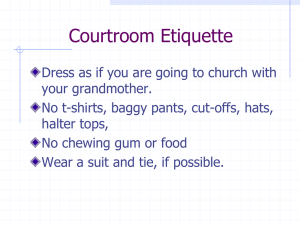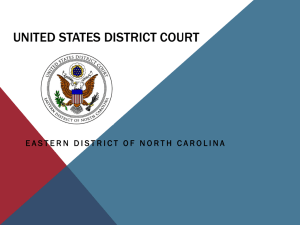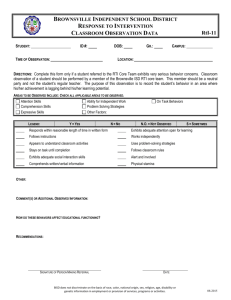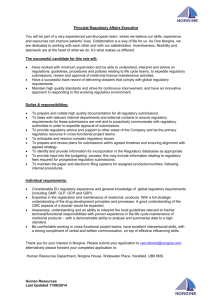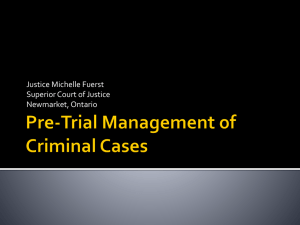1 ONTARIO E-DISCOVERY IMPLEMENTATION COMMITTEE WHAT
advertisement
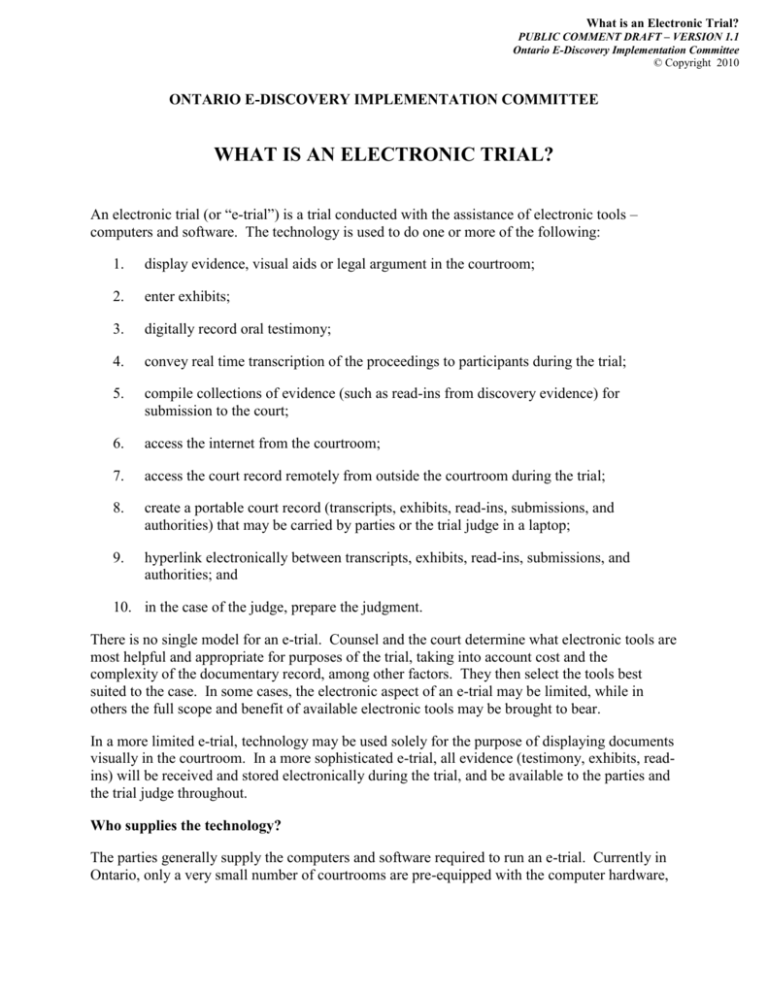
What is an Electronic Trial? PUBLIC COMMENT DRAFT – VERSION 1.1 Ontario E-Discovery Implementation Committee © Copyright 2010 ONTARIO E-DISCOVERY IMPLEMENTATION COMMITTEE WHAT IS AN ELECTRONIC TRIAL? An electronic trial (or “e-trial”) is a trial conducted with the assistance of electronic tools – computers and software. The technology is used to do one or more of the following: 1. display evidence, visual aids or legal argument in the courtroom; 2. enter exhibits; 3. digitally record oral testimony; 4. convey real time transcription of the proceedings to participants during the trial; 5. compile collections of evidence (such as read-ins from discovery evidence) for submission to the court; 6. access the internet from the courtroom; 7. access the court record remotely from outside the courtroom during the trial; 8. create a portable court record (transcripts, exhibits, read-ins, submissions, and authorities) that may be carried by parties or the trial judge in a laptop; 9. hyperlink electronically between transcripts, exhibits, read-ins, submissions, and authorities; and 10. in the case of the judge, prepare the judgment. There is no single model for an e-trial. Counsel and the court determine what electronic tools are most helpful and appropriate for purposes of the trial, taking into account cost and the complexity of the documentary record, among other factors. They then select the tools best suited to the case. In some cases, the electronic aspect of an e-trial may be limited, while in others the full scope and benefit of available electronic tools may be brought to bear. In a more limited e-trial, technology may be used solely for the purpose of displaying documents visually in the courtroom. In a more sophisticated e-trial, all evidence (testimony, exhibits, readins) will be received and stored electronically during the trial, and be available to the parties and the trial judge throughout. Who supplies the technology? The parties generally supply the computers and software required to run an e-trial. Currently in Ontario, only a very small number of courtrooms are pre-equipped with the computer hardware, 2 networking and software required in order to support an electronic trial.1 While parties are encouraged to make use of these facilities when available, the reality is that in many instances these model electronic courtrooms may not be available or may not be suited to the requirements of the particular case. In that event, the technology needed to implement the e-trial must be supplied by the parties, in consultation with the trial judge and with the cooperation of the court administration. If the parties wish to hold an electronic trial, the judiciary and court staff will in most cases support the parties’ decision, and will facilitate the process of equipping the courtroom with the necessary technology as supplied by the parties. At the end of the trial, all hardware and networking is removed from the courtroom by the parties. How are documents displayed during an e-trial? Although there are different ways of conducting an e-trial, a common practice is for the parties to prepare an electronic joint book of documents (JBD), that is either hosted on a computer within the courtroom, or hosted outside the courtroom and accessed remotely from the courtroom by internet connection. Examining counsel (or, usually, their co-counsel or law clerk) controls the electronic JBD while examining, and selects documents from the JBD to display during the course of the examination. A video splitter causes the selected document to be displayed on the video monitors of the judge, the witness, the court clerk and all counsel, as well as and on a public monitor, if one is used. On cross-examination, and on any re-examination, control over the electronic JBD is transferred to cross-examining or re-examining counsel, who displays documents in the same way. Each document in the electronic JBD has its own unique identifier, and the documents are indexed in an electronic table that may be organized by date, author, recipient, unique identifier, exhibit number (if marked as an exhibit), or any other descriptor the parties agree upon. The documents in the JBD are not exhibits until properly entered as such on an individual basis through witnesses. How are exhibits entered? Once a document within the electronic JBD is proved through a witness and order marked as an exhibit, the court clerk assigns an exhibit number that is entered electronically into a separate column in the index table of the electronic JBD. Depending on the applicable court procedures, the court clerk may also maintain a paper exhibit list, or paper copies of the exhibits. For oversized and non-documentary exhibits, the traditional method of marking exhibits will be used, with a corresponding entry into the JBD describing the exhibit and identifying that it was physically marked. Updated electronic copies of the exhibit list may be provided to the parties and the judge on a daily basis. Does displaying documents electronically interfere with examination strategy? No. None of the strategies typically employed by counsel in examining witnesses on documents is foreclosed by the use of electronic tools. Rather, the electronic display of document facilitates 1 For example, Courtroom 2-7 at 361 University Avenue in Toronto (used for criminal trials), and Courtroom 807 at 393 University Avenue in Toronto (available for civil trials). 3 locating and displaying documents quickly and efficiently, avoiding the delays associated with having counsel, the witness and the judge all trying to find the same paper document within stacks of binders. Electronic tools also offer additional options for manipulating documents effectively – permitting, for example, electronic methods of highlighting key words and passages, and easy transitions back and forth between multiple documents. At the same time, where counsel consider it necessary for strategic or other purposes, they may still use paper copies of selected exhibits with a witness. Indeed, a useful practice, particularly on cross-examination, is to prepare a paper copy of the exhibits for the witness, to ensure that the witness is given a fair opportunity to review the entire document rather than only the passage highlighted by counsel. How are read-ins presented? Many forms of litigation support software (e.g., Summation) permit counsel to prepare electronic compilations of information, which can be hyperlinked to transcript excerpts, exhibits and other materials. At the parties’ option, an easy method of preparing electronic read-ins is to organize the read-ins by subject matter, with a hyperlinked list under each subject heading of the relevant transcript excerpts for the read-ins. Opposing counsel and the judge can be supplied with an electronically loadable copy of the read-in compilation, and a copy can be filed electronically with the court clerk. Is internet access required (or available)? An e-trial does not require internet access in order to function, if the parties choose to host the electronic joint book of documents in a computer located in the courtroom. However, internet connectivity can increase the benefits of an e-trial. One internet-based e-trial option is for the electronic JBD, or the broader trial record (e.g., including transcripts, read-ins, submissions, etc.) to be web hosted by a third party. In that scenario, the parties and the court access the electronic JBD through the internet from inside the courtroom throughout the course of the trial, with documents being displayed remotely. An advantage of webhosting the electronic JBD and other materials is that parties and the judge can access the trial record remotely when the court is not sitting, without the need for regular transfers of exhibit information and transcripts from the court computer to the personal computers of the judge and the parties. Even if a webhosted e-trial format is not used, parties may nonetheless wish to have internet access during the trial for other purposes, such as for remote connection to counsel’s office, or to access internet search engines or other information. Currently, only selected courtrooms in Ontario have internet connectivity. If internet access is required for purposes of the e-trial, counsel should coordinate with the court administration to ensure that the trial takes place in a courtroom that connects to the internet. How does real time transcription work? When the parties choose to use real time transcription, a court reporter who is trained in real time transcription is selected, with the assistance of the court administration. Networking cables are placed between the court reporter’s computer and the video monitors viewed by counsel and the 4 judge, to allow the typed transcript prepared by the court reporter to be simultaneously displayed on all of the screens as witnesses, counsel and the judge speak. (Typically, each counsel table will feature one monitor connected to the court reporter for the real time transcript, one monitor connected to the video splitter for displaying documents, and a third monitor for private use.) The running real time transcript is saved to a hard drive on a running basis by each receiving party, so that it can be reviewed immediately as required, without having to wait for the court reporter to send a complete copy. At the end of the court day, the court reporter typically prepares a corrected version of the day’s rough draft of the transcript. Real time transcription is generally favoured by counsel who have used it, in particular because it facilitates cross-examination, re-examination, and the articulation of objections. What is the purpose of digital recording of oral evidence? Digital recording of oral evidence means the recording of the audio portion of a trial (the oral evidence, the submissions of counsel, etc.) onto a computer rather than a tape or other non-digital medium. Arrangements can be made for both the parties and the court to receive and store the audio on their computers, or to access the audio remotely through a web host. The benefits of digital recording of the audio include ease of access, the ability to verify the transcript against the audio, and the ability to replay evidence easily in audio form without the intervention of the court reporter. How are legal submissions made during an e-trial? Oral opening and closing submissions during an e-trial are generally delivered in coordination with the electronic display of relevant documents, whether those documents are exhibits (or anticipated exhibits in the case of opening submissions), transcript excerpts, audio excerpts from oral evidence, or authorities. A common practice is for counsel to prepare an electronic compendium, with key documents and authorities assembled into an electronic collection that can be brought up onscreen in the courtroom on a document by document basis as needed during the course of submissions. For written submissions, parties to an e-trial may choose to deliver their submissions on disk or a thumb drive in hyperlinked format, with all citations or footnotes electronically linked to the evidence and authorities they cite. This format makes the submissions and key evidence portable and easy to use for the benefit of the trial judge. What use does the judge make of the electronic materials? Judges who have presided over e-trials find the electronically stored evidence and submissions helpful both during trial and when preparing a judgment. Among other things: the evidence and submissions are highly portable, and can be carried on a laptop, or accessed remotely by internet, allowing the judge 24-hour access to all exhibits, testimony, read-ins, submissions and authorities; 5 all of these materials are easily searchable, allowing the judge to locate specific pieces of evidence, or all evidence on a point, or all parties’ submissions on an issue, very quickly; and the evidence and submissions can be manipulated easily, allowing the judge to: (a) cut and paste excerpts from exhibits, transcripts, submissions or authorities; or (b) easily create footnotes or citations to the evidence and authorities. How much does it cost? In most cases involving modest to large volumes of documents, the cost of an e-trial will be less than the cost of conducting the same trial using a paper record. Taking into account the substantial reduction in preparation time and trial time associated with the efficiencies of the electronic tools, as well as the reduced photocopy costs (particularly in document-heavy cases), an e-trial will generally result in a net cost savings. This is true even taking into account the likely need to retain an outside IT consultant to assist in implementing the e-trial. For more detailed information on the likely costs of an electronic trial, see the companion document, “Benefits and Costs of an Electronic Trial”. Is an IT consultant required? An IT consultant will generally be required to coordinate the logistics of an electronic trial. The IT consultant’s work will likely include some or all of the following: (a) assembling the JBD; (b) supplying hardware and software to run the e-trial; (c) assembling the network of computers and monitors in the courtroom; (d) training court staff and the trial judge; (e) periodically adding exhibits, transcripts and other materials to the trial judge’s laptop if one is used; (f) answering day-to-day inquiries by the trial judge, court staff and counsel; and (g) troubleshooting. The most efficient approach is usually for the parties to retain an IT consultant on a joint basis. The cost of the consultant is shared between the parties on an agreed basis, subject to reallocation as part of any costs award at the end of trial. What steps should counsel take to prepare for an e-trial? A review of the key steps to be taken by counsel in preparing for an electronic trial is contained in the companion document, “E-Trial Checklist”.
